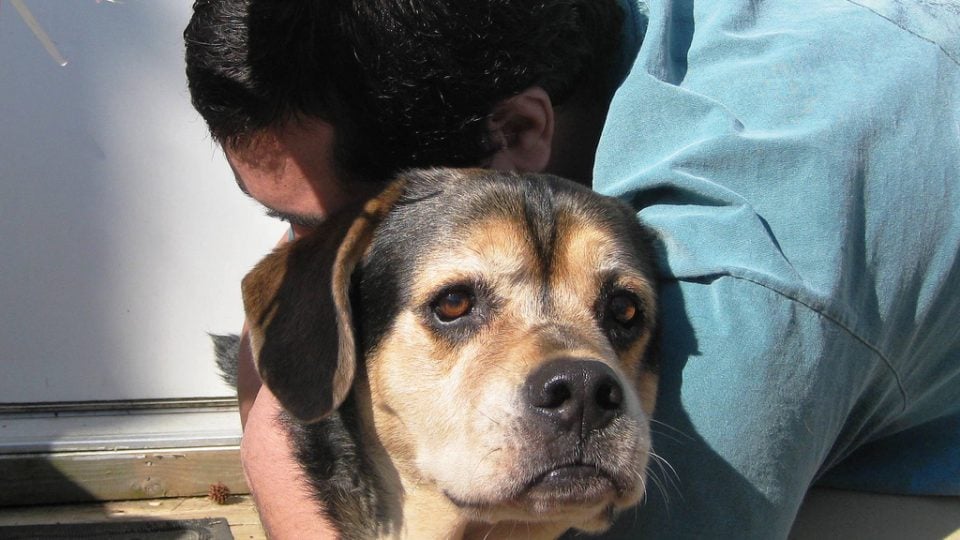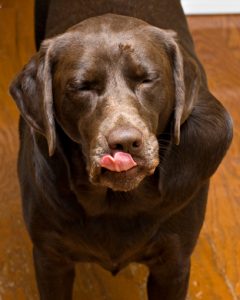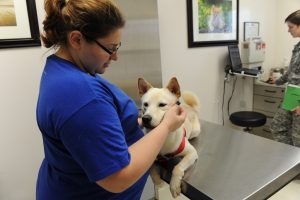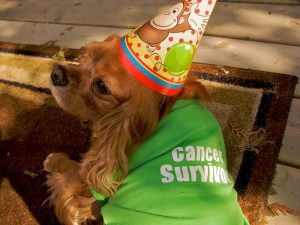It’s so obvious it doesn’t need saying, but we’ll go ahead and say it: cancer sucks. It’s a scary, insidious disease, and when it hits our dogs, its especially upsetting because they can’t tell us where it hurts.
According to a WebMD interview with veterinary oncologist Dave Ruslander, 50% of dogs over age 10 will develop a form of cancer. It’s the leading cause of natural death among dogs, which makes it sound awfully scary.
The truth is, one of the main reasons dogs are getting more cancer is that they’re living longer and longer, and as the body ages, it becomes more vulnerable to disease. Whether your dog is young or old, it’s important to be aware of how to catch and treat dog cancer before it’s too late.
Learn to Spot the Signs of Dog Cancer
Early detection is the key to successful dog cancer treatment, so familiarize yourself with the most common dog cancer warning signs. According to the ASPCA, these include:
- Lumps (while not always signs of cancer, new or growing lumps should always be examined by a vet)
- Unusual swelling
- Wounds that won’t heal
- Abnormal bleeding or discharge from any part of the body
- Bad breath
- Listlessness/lethargy
- Rapid, often unexplained weight loss
- Sudden lameness
- Black, tarry stools
- Decreased or loss of appetite
- Difficulty breathing, urinating, or defecating
Of course, it’s also possible for a dog to develop cancer without showing any of the classic warning signs. You should always consult a vet if your dog seems suddenly “off,” or if they develop a new growth or symptom.
Check Your Dog for Tumors
You can perform a “lump check” on your dog the same way you do on yourself: about once a month, gently feel your dog all over to check for new or unusual growths. If your female dog was spayed after her first heat (past the age of one year or so), pay special attention to the area around her nipples, as mammary tumors are common signs of breast cancer in dogs. Dog skin cancer also frequently presents with lumps, so be thorough in your check. (You can learn more about the most common types of dog tumors at doghealth.com).
Keep in mind that as dogs age, they are more likely to take on a few benign lumps and fatty deposits, and not all dog bumps are dog cancer bumps. Conducting monthly lump checks on your dog will help you track existing, harmless lumps and notice new ones before they become problems.
Know About Common Dog Cancers
Dogs are susceptible to a wide array of cancers. Some of the most commonly-diagnosed and asked-about forms of dog cancer include:
- Malignant lymphoma, or tumor of the lymph nodes
- Breast cancer, or mammary gland tumors, the most common cancer for female dogs
- Bone cancer, often affecting the leg joints and presenting as lameness
- Colon cancer, less common in dogs but very serious if diagnosed. Tumors in the colon (as well as dog prostate cancer) are usually tied to intestinal cancer, and according to Veterinary Clinics of America, are more likely to affect dogs age 9 and up
- Soft tissue sarcoma, or tumors that arise from skin or subcutaneous tissues (source). The most common treatment for sarcomas is surgery to remove the tumor(s), and dogs whose sarcomas are caught and removed early enough have a very good prognosis.
- Mast cell tumors typically present as lumps on or under the skin, and they are not always malignant (source), which makes them tricky to diagnose.
Some breeds are more likely to get certain types of cancer. For instance, large dogs like Great Danes and Bernese mountain dogs have a higher incidence of bone cancer, while bull terriers, boxers, and other bully breeds are more likely to develop mast cell tumors. Researching your dog’s breed can help you know what kind of symptoms to watch out for as your dog develops. You can learn more about the many types of cancer from the VCA Resource Library.
Practice Dog Cancer Prevention
The biggest step you can take towards preventing dog cancer is to spay or neuter your pet. According to the ASPCA, a female dog spayed before her first heat is 2,000 times less likely to develop mammary cancer, and neutered males have zero chance of developing testicular cancer. Regular teeth brushing, lump checks, and veterinary check-ups can also help prevent cancer in dogs. Though sun exposure has not been directly linked to skin cancer in dogs, sunscreen is a good idea, too.
Lung tumors are rather uncommon in dogs, but they are very scary because dog lung cancer life expectancy is short (as little as four months, according to the University of Florida College of Veterinary Medicine). Thankfully, there’s one easy thing you can do to help prevent dog lung cancer: don’t smoke around your pet. The ASPCA reports that secondhand smoke puts pets at risk of lung and throat cancer, and you know it puts you at risk, too. While you’re at it, why not give up smoking altogether? It will help you and your pet stay healthy together longer.
Unfortunately, dog cancer prevention is tough because we just don’t know all of the causes. But catching cancer early is just as important as preventing it; the earlier it’s caught, the better the prognosis.
Explore All Treatment Options
If your dog does receive a cancer diagnosis, you’ll likely be scared and sad. But there are treatment options for most types of cancer. Dog cancer treatments include many of the same ones available to us humans when we have cancer:
- Chemotherapy, or aggressive chemical/drug treatment
- Radiation therapy, which uses intense beams of energy to kill cancerous cells
- Surgery to remove tumors and/or cancerous tissue
- Palliative care, or pain management, used in cases where cancer is unfortunately too aggressive to treat successfully, but quality of life can be maintained for some time
Some cancers require more than one type of treatment, and prognoses vary depending on the type of cancer and how far along it is before it’s discovered. The good news is, many cancers are treatable. According to Dr. Ruslander at WebMD, survival rates for the majority of malignancies is “probably in the 60-plus percent range” if treated.
Of course, if cancer is left untreated, survival time lessens. That’s why it’s so important to check your dog for new or unusual symptoms, and consult your veterinarian if anything seems amiss.
Don’t Live in Fear of the C-Word
It’s not a happy thing to think about, but a dog dying at age 15 from cancer is a dog who lived a full life and ultimately died of natural causes. Cancer is scary, and it’s important to check your dog for signs and be prepared to combat the disease if it comes. But it’s also important to note that overall, thanks to advances in veterinary medicine and a focus on preventative care, our dogs have increased lifespans and better quality of life than they did just a couple generations back.
Now, go give your dog a big hug (and start practicing those lump checks while you’re at it).
The information provided in this article is not a substitute for professional veterinary help.






